Get ready to dive deep into the intricacies of managing your Google Ads account. In this article, we explore the challenges faced by digital marketers, such as collecting and analyzing data, optimizing campaigns, and meeting time constraints. Thankfully, Google offers a range of time-saving options fueled by their vast data resources. But do these options truly enhance campaign performance? Join us as we share real-life experiences from working with different Google Ad accounts and uncover the truth behind these tools. Together, we’ll examine their effectiveness and determine their impact on campaign success.
Targeting Tools
Crafting effective targeting strategies is essential for maximizing the success of your Google Ads campaigns. When it comes to search campaigns, you have the power to fine-tune your targeting by carefully selecting keywords and utilizing different match types. On the other hand, display campaigns rely on building audiences or leveraging the available audience options within the Google Ads platform. In the following sections, we will delve deeper into these targeting methods and explore their potential impact on your campaign performance.
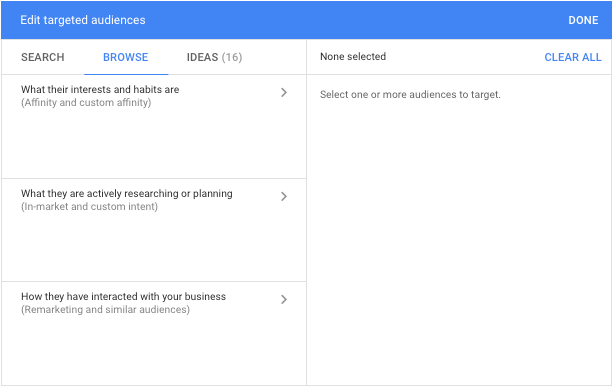
Expanding your targeting reach is made possible through various options offered by Google for different campaign types. In the case of search campaigns, you can opt to display your ads on Google search partners, which significantly broadens the scope of your Google search ads to numerous non-Google websites. This reach can even extend to popular platforms like YouTube and other Google sites. It’s important to note that when selecting this option, you will receive a notification stating that “most advertisers include their ads on Google search partner sites.”

After auditing an account, we found a client of ours did indeed decide to include search partners and saw the following results:

We have observed a significant increase in conversion volume from search partners; however, the cost-per-conversion also tends to be higher in these cases. Furthermore, Google search still holds a 90.25% impression share, indicating that there is ample opportunity to display ads on Google search. By allocating a larger portion of the budget to Google search and slightly reducing the investment in search partners, this client could have achieved conversions at a lower cost and ultimately reduced the overall cost-per-conversion in the campaign.
When it comes to setting up a display campaign, you can enhance your reach by leveraging automated targeting options.
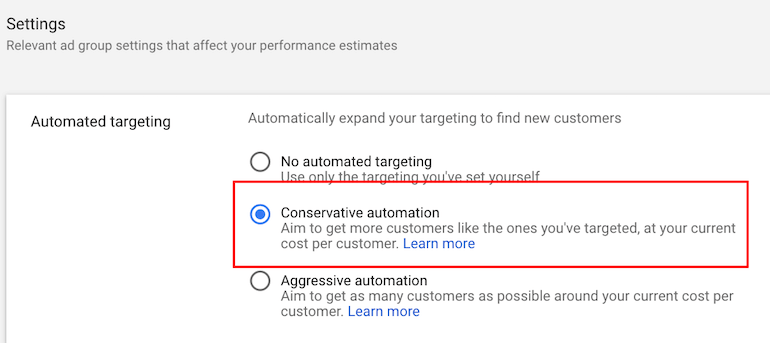
Impressive, isn’t it? One of our clients implemented the mentioned settings for a remarketing campaign, and here’s how it performed overall:

Something seems amiss here!
You would expect a higher conversion rate than 0.25% when targeting users who are already familiar with your brand, right? So, what went wrong? Upon analyzing the performance of site visitors, we observed the following:

And in comparison, this is how the set of conservative automation performed:

We observe a significant disparity in performance here. Despite being set to a “conservative” automation level, 82% of the budget was allocated to automation, which resulted in much worse performance. It’s crucial to prioritize proper targeting as the cornerstone of your campaign’s success. Keep this in mind at all times.
If your goal is lead generation, it’s advisable to avoid opting for automated targeting unless you feel you have exhausted other options. Even then, don’t set it and forget it; you could end up wasting ad spend on audiences you have no control over.
On the other hand, if your goal is to increase brand awareness, these options can be an excellent way to expand your reach, gain more exposure, and drive increased traffic to your website.
Bid Builder
Managing a large number of keywords in your account can be a cumbersome task when it comes to manual bidding. However, Google’s smart bidding options offer a solution by automating the process of tracking and adjusting keyword bids. With multiple options available, you can choose the one that best aligns with your campaign goals and objectives. This not only saves time but also ensures that your bids are optimized for maximum performance.
- Target CPA: Adjusts bids to achieve the maximum number of conversions while maintaining the average cost-per-acquisition (CPA) goal.
- Target ROAS: Optimizes bids to maximize conversion value while ensuring the desired return on ad spend (ROAS) is maintained.
- Maximize Clicks: Adjusts bids to maximize the number of clicks your ads receive within the specified budget.
- Target Search Page Location: Adjusts bids to increase the likelihood of your ads appearing at the top of the search page or on the first page of search results.
- Target Outranking Share: Modifies bids to surpass competing ads from another domain.
- Enhanced CPC: Automatically adjusts manual bids to optimize conversions.
- Target Impression Share: Sets bids automatically to increase the chances of your ads appearing in the selected search page area.
These options can be highly advantageous depending on the specific goals of your campaign. We had the opportunity to work with a client who had a well-established campaign with a substantial amount of conversion data, averaging approximately 200 conversions per month. It’s worth noting that the more conversion data available, the more effective Google’s algorithm becomes at quickly adapting and generating optimal results within a shorter timeframe. In order to further explore the effectiveness of different bidding strategies, we conducted an experiment comparing the performance of maximizing conversions against a manual bidding strategy. The results we obtained were quite intriguing.
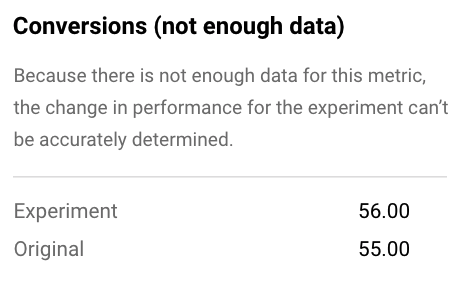
Despite monitoring the campaign for a few weeks, we did not observe significant disparities in terms of volume or conversion rate. However, the notable distinction lied in the costs associated with each bidding strategy:
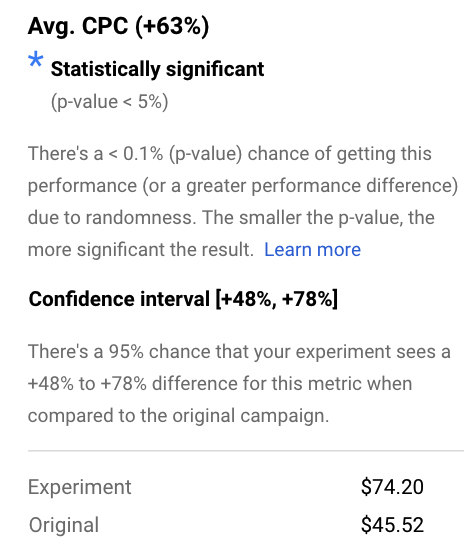
After implementing the automated bidding strategy, we experienced a staggering 63% increase in CPC. Although the conversion volume remained stagnant, our CPA skyrocketed. Consequently, we decided to terminate the experiment and revert to manual bidding.
However, it is crucial to note that automated strategies are not always wasteful. In fact, we have witnessed remarkable results with this approach in one of our client’s campaigns, boasting the highest volume and lowest CPA ever achieved.
The Target CPA strategy proved effective in enhancing performance and improving account-level CPA. Additionally, the Target Impression Share feature helped us achieve the goal of displaying high-value keywords 100% of the time.
The key takeaway is to conduct thorough experimentation before making any switches. Results can vary depending on factors such as industry, offer, and the distinction between branded and non-branded keywords. Personally, I have found these strategies to be most effective after running a campaign for a substantial duration and optimizing it extensively. Once the campaign is established, experimenting with Smart Bidding can propel it to the next level of success.
Creative Collaboration
So far, we have primarily focused on the backend aspects of Google Ads, but what about the creatives that your customers see? Google has a solution for that too, known as responsive search and display ads.
With responsive search ads, you can input multiple headlines and descriptions, and Google will automatically test different combinations to find the most effective one. This feature eliminates the need to create numerous ad variants manually in order to identify the winning copy. Let’s examine an example:

Although the click-through rate appears impressive, the cost-per-acquisition (CPA) is not as desirable. What’s even more concerning is the lack of visibility into what specifically is causing the wasted spend. If you click on the “view asset details” as highlighted above, you will encounter the following information:
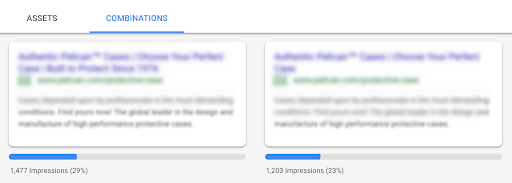
The available data on responsive search ads only provides information about the different combinations and their respective impression numbers. Unfortunately, it lacks crucial metrics such as conversion numbers, conversion rates, and cost-per-conversions associated with each combination. This limitation prevents us from effectively identifying successful ad variations and pausing underperforming ones. While responsive search ads have the potential to revolutionize advertising, the absence of comprehensive statistics hinders our ability to analyze and optimize copy performance. For instance, a combination that generates a high number of clicks may not resonate well with the landing page compared to another combination with fewer clicks. Without the necessary data, it’s challenging to make informed decisions. On the display side, responsive display ads streamline the process by allowing you to upload an image and accompanying copy, which Google can then adapt to fit different ad placements, similar to responsive search ads.
We conducted a test comparing one of these responsive display ads against our standard banner ads, and the results were impressive. The top row displays the metrics for the entire ad group, while the bottom row specifically highlights the metrics for the responsive display ad:

The responsive display ad proved to be highly effective, generating more than half of the ad group’s conversions while accounting for less than a quarter of the total spend. Automation showed promising results in this case. However, similar to responsive search ads, the lack of detailed insights makes it challenging to determine what aspects are driving success. To gain a better understanding, we paused the manually built display ads and conducted further tests between different variations of responsive ads. Although responsive ads can save significant time in the creative process, the absence of comprehensive insights hinders our ability to identify the messaging that seamlessly guides users from the ad to the landing page and towards the desired conversion. Nevertheless, it is advisable to include responsive ads in your arsenal and experiment with them alongside your existing ads to evaluate their performance for your specific campaigns.
Overview and Recommendations Refresh
If you have a large Google Ads account and are unsure where to begin, these tabs provide you with overall insights into your campaigns, ad groups, and keywords. They offer a convenient way to review and analyze the performance of your advertising efforts.
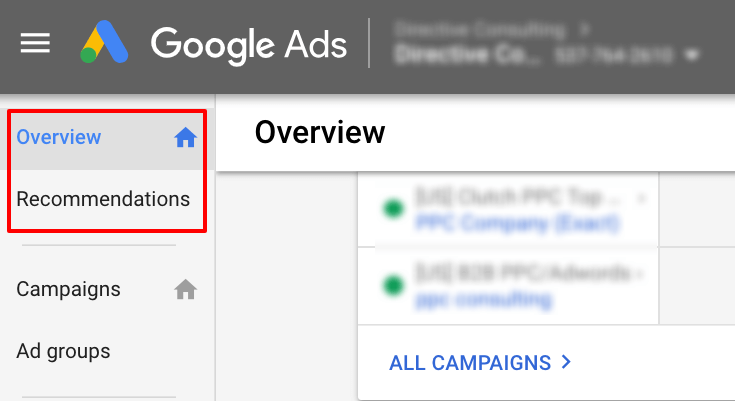
This tool enables you to obtain a broad understanding of trends and anomalies within your Google Ads account. The Overview section, for instance, provides insights into the triggering keywords for your ads, saving you the hassle of manually searching through individual search terms. It allows you to quickly identify relevant information without extensive digging.
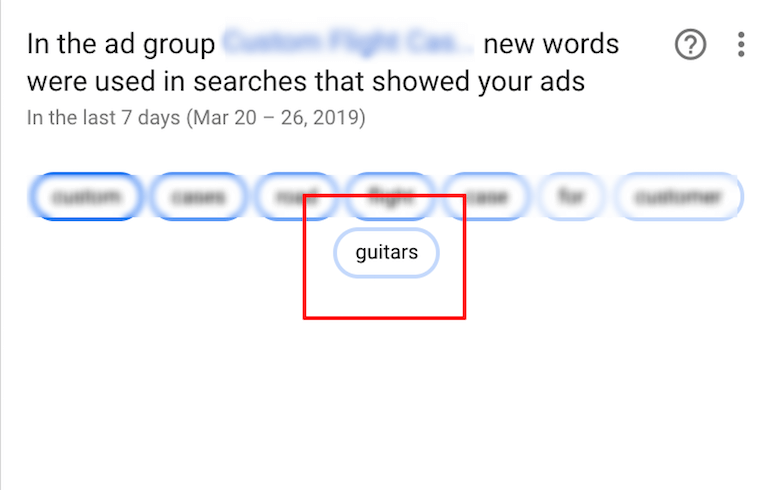
If you notice a significant number of irrelevant terms in this section, it serves as a clear indication that you need to optimize your search terms and incorporate negative keywords. In the given example, we have identified a word that triggered our ad but is unrelated to our services. Adding this word as a negative keyword ensures that our ads are not displayed for irrelevant searches. Removing such keywords is vital for minimizing wasteful spending and ensuring that your ads are targeted towards relevant searches.
Moving on to the Recommendations tab, it provides suggestions on areas where you can increase your ad spend or expand your campaigns. However, it is important to approach these recommendations with caution as they may not always align with your campaign goals.
As an example, during our video campaign, we received the following recommendation:

Seems pretty straightforward, right? Just increasing our daily budget should result in more video views. But what about the engagement metrics? Are these viewers actually visiting our website? If they do, how long do they stay? And if they don’t, how many pages do they explore?
The purpose of this campaign was to raise awareness for our client’s product and determine if video ads successfully drove users to the site. We were more interested in evaluating audience behavior and whether they took action after watching a teaser clip, rather than simply reaching a wide audience with the video.
Unfortunately, the above recommendation doesn’t provide these insights; it only focuses on increasing costs and views. Click-through rate, bounce rate, and pages per session are more meaningful metrics to assess your goals, and they should be considered before allocating more budget for additional views.
Remember, these recommendations are just suggestions. Use them as a guide to identify areas for further exploration within your account. However, always investigate and analyze the data before blindly increasing your budget.
More spending for visibility alone doesn’t guarantee improved account performance.
Final Focus
Setting up a Google Ads account with the aim of optimizing your paid search strategy can be a time-consuming process that requires careful planning and research.
Given the multitude of tasks within the account, it’s tempting to rely on Google’s automation features and let the system run on autopilot. However, taking shortcuts early on can lead to underwhelming performance and wasted ad spend in your PPC campaigns.
But isn’t automation designed to learn, adapt, and enhance our search marketing efforts? Well, as the frequently heard phrase in Directive’s pay-per-click department goes, “it depends.”
While automation options are available to simplify your workload, they don’t come with guaranteed success. Should you give them a try? Absolutely. Optimize your campaigns first, then test out automation, but closely monitor the performance within your account. Be diligent and ensure there are no vulnerabilities in your search marketing campaigns that could allow automation to deplete your paid search budget.
